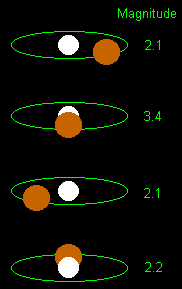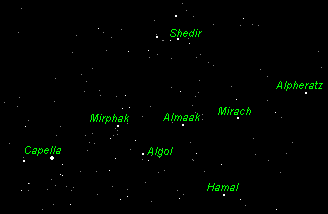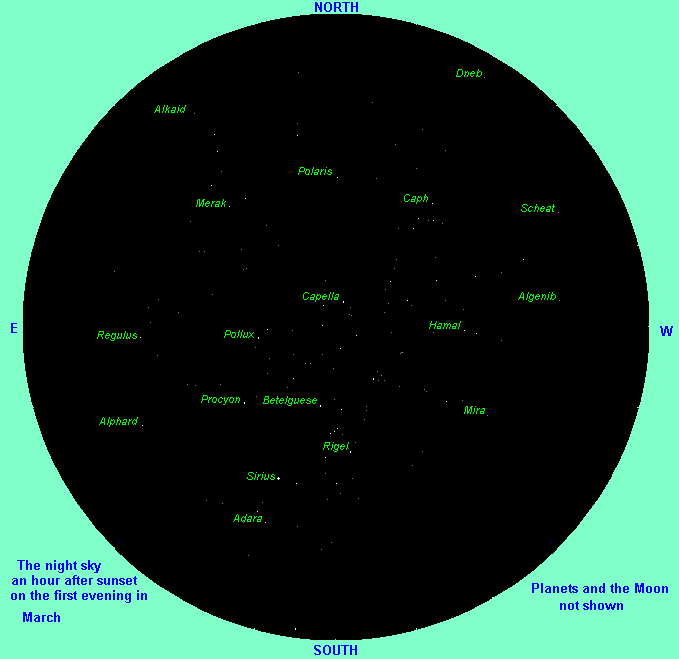The March sky is dominated by brilliant constellations such
as Orion but this month also provides an excellent opportunity
for the amateur to extend his or her observations to a particularly
interesting sight - Algol. Throughout the month of March, Algol
is nearly overhead at sunset and visible the entire evening. This
star is easy to overlook because it's not nearly as bright as
some stars in the night sky but it is Algol's brightness that
makes it so unusual and fascinating. You see, Algol's brightness
changes  making it a so called "variable star".
There are many different reasons for a star to change its brightness.
Some change due to an intrinsic property of their complicated
astrophysics. Other stars change brightness because they are regularly
eclipsed by a darker companion orbiting around it. Algol is of
the latter type - an eclipsing variable.
making it a so called "variable star".
There are many different reasons for a star to change its brightness.
Some change due to an intrinsic property of their complicated
astrophysics. Other stars change brightness because they are regularly
eclipsed by a darker companion orbiting around it. Algol is of
the latter type - an eclipsing variable.
|
The star we see as "Algol" is actually the brighter
of the two stars so technically we should call it "Algol
A". It has a magnitude of 2.1. That's fairly bright. In fact,
Algol A is about 100 times as bright as our Sun but it's much
farther away. Orbiting Algol A, like a planet, is Algol B, a
very dim star. Fortunately, for the amateur astronomers of Earth,
the plane of Algol B's orbit is along our line of sight. That
means Algol B passes in front of Algol A during its orbit. As
it does so, Algol B eclipses Algol A, blocking most of the light
from the brighter star. During this eclipse "Algol"
dims from a magnitude of 2.1 to 3.4.
It takes Algol B exactly 2 days, 20 hours, 48 minutes and 56 seconds to complete its orbit around Algol A. Each eclipse lasts about 10 hours but it's during the middle 2 hours that the maximum eclipsing occurs. Like most orbits, the orbit of Algol B is very precise so, like clockwork, "Algol" dims every 2 days, 20 hours, 48 minutes and 56 seconds. There is a slight drop in magnitude when the secondary moves behind the primary but it's only a small amount. It drops from 2.1 to 2.2 - too small a change to be noticeable. |

|
If you change all those times to common units, such as fractions of day, you will find that the entire cycle takes 2.867315 days which is much more convenient than 2 days, 20 hours, 48 minutes and 56 seconds!
|
This is a fascinating event to watch but, of course, the first
thing you have to do is find Algol. These directions will help
you. (And the monthly map at the end of this webpage will help
you to orient the brighter stars I'm taking about here.)
Imagine a line from the very bright star Capella to the (not quite so) bright stars of Almaak, Mirach and Alpheratz. There is a star on either side of the line between Almaak and Capella, about midway between them. The one to the north is Mirphak but the one to the south is our target - Algol. (Don't confuse it with the brighter star Hamal.) |

|
Now that you know where it is, you'll want to know when to watch for Algol to dim. It helps to know the times to expect these eclipses and this information can be calculated from the information above. All you have to do is continuously add 2.867315 days to a previous minima (such as March 29th at 16:45 in the year 2000) until the dates comes back around to this time of year! Or just watch Algol for a few days and notice how its brightness fluctuates.
This is a wonderful sight to see. Use Almaak, which always has a magnitude of 2.1 (Algol's normal magnitude), as a reference. At minima, Algol will be as faint as either of the two stars flanking it.
By the way, the Equinox occurs around March 21st. On that day the Sun will appear to move from south to north across the equator and we will experience equal amounts of day time and night time. This event signals the start of spring in the Northern Hemisphere so northerners call this day the Spring (or Vernal) Equinox. Folks in the Southern Hemisphere call this day the Autumnal Equinox because it signals the start of their autumn.
|
Your sky map for the month of MarchHere's a map of the clear, night sky as seen from the center of the USA on the first evening of this month, an hour after sunset. Specifically, this is the view of a clear sky from a latitude of 37N. Star-gazers farther north, such as in Minneapolis, Chicago and most of Europe, will have more of the northern sky visible and the southern sky will be obscured by the horizon. Vice versa for those who are farther south. The stars will not change position relative to each other, however, throughout the month, the Moon and planets will wander, so they are not shown. Only objects of magnitude 4.0 and brighter are displayed. Here's a reverse color image of the map that will be easier on your printer. |  |
On the 25th of March 1655, Saturn's largest satellite, Titan, was discovered by Christian Huygens. This is the only moon in our Solar System that has a significant atmosphere. Titan's atmosphere produces a surface pressure 1.5 times that of the Earth's and is composed of about 90% nitrogen with most of the rest being methane. In 2004 the Cassini mission sent a lander, named Huygens, to Titan's surface.
On the night of March 13th in 1781 William Herschel discovered what he thought was a "dormant" comet. Further observations and calculations of its orbit proved that it was a planet far beyond the orbit of Saturn, which was regarded at the time as our most distant planet. It was named "Uranus" who, according to mythology, was the father of Saturn.
Sputink 10 carried a dog, named "Zvezdochka", into space on March 25th, 1961.
Alexei Leonov stepped out of his spacecraft, Voskhod 2, on the
18th of March 1965 to become the first man to walk in space! Ten
minutes later he stepped back in. (Must have been cold.  )
)
On the 8th of March 1979 images returned from the Voyager 1 fly-by were used to detect volcanic activity on Io, the closest moon to Jupiter. Since then we have learned that Io is the most volcanically active planet in the Solar System.
I hope you found the Night Sky this Month to be helpful and educational. I invite you to return here monthly for new information.